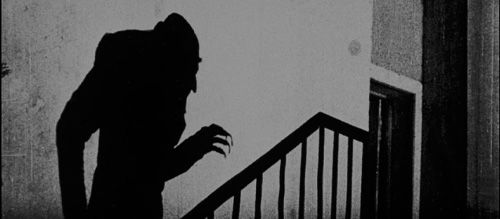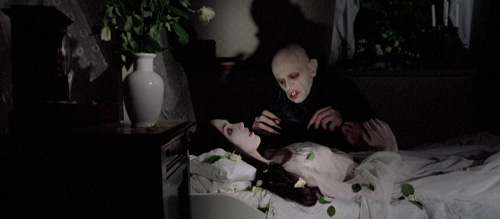Original vs Remake: Nosferatu vs Nosferatu the Vampyre
The horror film genre probably has more remakes in its ranks than any other, and there is no tale of horror told as frequently as those based on Bram Stoker’s 1897 vampire novel “Dracula”. Of the hundreds of adaptations for cinema made over the course of a century, from Universal to Hammer, from filmmakers as far-ranging as Francis Ford Coppola (Bram Stoker’s Dracula) and Paul Morrissey (Blood for Dracula), the most instantly recognisable and certainly the most influential film of the horror genre is F.W. Murnau’s Nosferatu released in March 1922 in Germany, a film that was subsequently ordered to be destroyed following an uncompromising copyright lawsuit.
Never mind rebooting a recognisable franchise, if you’re going to remake an absolute classic you’d better have a good reason to, and make sure that you have something new to say with the material, a seemingly insurmountable challenge eccentric German polymath Werner Herzog took on 57 years later to surprising success.
Despite using different names and locales, both films roughly follow Stoker’s story of a vampire aristocrat travelling by ship to distant shores where he hunts and enthrals several people linked to the solicitor who sold him his new home and uncovered his secret. Characters are renamed and their roles in the plot switched or downgraded, but the broad strokes are all there. So which of these cinematic adaptations of ‘Dracula’, the unauthorised silent trailblazer or the full colour and sound reinterpretation, stands up the best today? Allow us to sink our teeth into that question in this edition of Original vs Remake.

100 years ago, Weimar German filmmaker Friedrich Wilhelm Murnau made a name for himself when he released Nosferatu, an unauthorised film adaptation of Bram Stoker’s “Dracula”. So unauthorised was it that the Stoker estate, in care of the author’s widow, sued for plagiarism and ordered all reels of the completed film to be destroyed. And yet, the film has still managed to become an enduring pillar of horror cinema and the originator of many vampire mythology tropes in various forms of popular culture to this day.
It’s incredible to think that one of the icons of silent cinema was nearly lost to history due to copyright infringement, only surviving due to some prints being illicitly hidden away, taken abroad and re-emerging post-WWII. This is undoubtedly one of the few occasions where piracy was good, actually.
Screenwriter Henrik Galeen, who also penned the screenplay for earlier German horror Der Golem, went through considerable effort to change all the key character names from “Dracula” (Dracula becomes Orlok, Harker becomes Hutter, Mina becomes Ellen) at the behest of his producer in an effort to avoid legal troubles, but it didn’t work. Still, there’s plenty to discuss about this litigious picture.
Many have written about the countless possible subtexts of the film, because vampires always bring subtext with them. The film was made by a gay director, and moreover it was produced in an inter-war Germany full of anxieties about its future and where the next threat may come from. The subplot about the fear of a plague arriving along with Count Orlok (Max Schreck) and the paranoia of the vampire stealing something precious from its victims (blood, virginity, piety, take your pick) would both seem to feed back to the outcast experiences of the film’s creators, not to mention commenting on increasing anti-Semitic and xenophobic views in Germany during this era.
Nosferatu is solely responsible for one of the main things we all know about vampires in popular culture: they die in daylight. That doesn’t come from Stoker, whose Dracula character was nocturnal and preferred to hunt at night and recuperate in his coffin during the day but was never stated to be deathly allergic to the sun. Again, this was Galeen attempting to differentiate the film from Stoker’s work by fundamentally changing its ending.
Murnau’s Nosferatu also provides us with two of the most indelible images in horror cinema: Orlok rising vertically from his coffin as if by some dark magic, and the shadow thrown against a wall as he stalks up a staircase to his lady victim. When it came to his remake, Werner Herzog could only really hope to tip his hat and pay tribute to such iconic moments.
This film’s version of vampire thrall Renfield, Knock (Alexander Granach), mischievously and seemingly with foreknowledge says to his employee Hutter (Gustav von Wangenheim) before embarking to Orlok’s castle to sell him a house: “The price is a little effort, some sweat and perhaps a little blood”. How true his words would become.
Aside from the instantly iconic imagery of a truly terrifying and otherworldly creature of the night, on a purely technical level the film appears ahead of its time, with very modern action/reaction shot editing in the tavern scene where the villagers react to Hutter saying he’s in a hurry to get to Orlok’s castle before Hutter reads about, and dismisses with a hearty chuckle, the local vampire legends that will ultimately seal his fate.
Over half a century later, Werner Herzog would craft his own take on Nosferatu and against the odds almost surpass it.

To say Herzog was an F.W. Murnau superfan puts it mildly, seeing him as he did as a masterful early filmmaker among the best his home country had ever produced and a major influence on his own work. Since the copyright to Bram Stoker’s book had handily just expired, he was free to tell a more faithful version of the “Dracula” story than his artistic inspiration had, or at least to use all the proper names. His Nosferatu the Vampyre would end up being a hybrid film that was part remake and part new and legal adaptation from the original source material.
It’s all the same scenes in pretty much the same order as the Murnau film, but the presentation and meaning behind them is often very different through the Herzog lens.
Renfield (Roland Topor) is still Harker’s (Bruno Ganz) sinister boss who sends him to sell property to Dracula, and you once again get the knowing “sweat and blood” line of dialogue before Harker departs on his journey.
The film strikingly incorporates Herzog’s trademark verité style whenever the outright gothic isn’t required; when it’s not showing us the dark delights of Dracula’s castle or his insatiable bloodlust, the camera hangs back and simply documents the real world moving past it. Speaking of documenting, Herzog seems keen to record and incorporate Romani Gypsy culture and have their traditions and superstitions suffuse the story more authentically than Murnau’s film or Stoker’s novel ever did in the scenes where Harker is getting a taste of the local superstitions.
You’re treated to some stunning natural beauty as Harker navigates the mist-shrouded mountain passes to Dracula’s castle, and it couldn’t feel more tangible since Herzog being Herzog really did send poor Bruno Ganz up that mountain. The use of real locations over studio confinement in addition to the classical orchestration and choral tones of the soundtrack undoubtedly help this version feel grander and more sweeping.
Herzog also gives Bela Lugosi’s famous “Children of the night” line from the Universal Dracula film to Klaus Kinski’s Count. The metaphor of the vampire as a pestilence to be eradicated is taken even further in this film through the vampire adopting a rodent-like appearance and the use of a veritable horde of real rats in any scene where he invades a foreign locale.
Harker being imprisoned in the castle and gradually drained by Dracula night on night is straight from the novel. Also taken from Stoker is the story being made up of several written accounts. It’s the form the narrative takes and some telling details that makes this more in-keeping with Stoker’s original words on the page.
In Herzog’s film, Dracula actually comes out and all-but admits to Harker what he is in his references to life and eternity.
Kinski isn’t quite as eerily hypnotic a presence as Max Schreck was (who else could be?) but his breathy, pained and neurotic Count is still pretty memorable, Herzog later in life described his lead actor appropriately and probably only half-jokingly as “a monster and a great pestilence.” Kinski must’ve pounced at the chance to play the titular creature of darkness in his second of five collaborations with Herzog, an unquestioned step up from playing supporting player Renfield in another European adaptation almost a decade earlier.
Isabelle Adjani’s Lucy (as in many of the film versions replaces the character of Mina who is married to Jonathan Harker in the novel) is a much more active player in this story, taking on many of Harker’s traits, not to mention the absent Van Helsing’s role in hunting Dracula from the latter stage of the novel as his screen version of Harker steadily loses his grip on reality.
Herzog’s films are always spiritual but often sceptical bordering on cynical about organised religion, as shown here by Lucy’s choice quote to Van Helsing (Walter Ladengast): “Faith is the amazing faculty of men which enables us to believe things which we know to be untrue”. Herzog bringing his usual perspective on the world to his re-telling of a popular story definitely adds to its already considerable power.
Not content with merely incorporating Murnau’s imagery in his new interpretation of “Dracula”, Herzog took his forebear’s dramatically different story conclusion and decided to take it even further by adding in a much darker twist ending than in all previous versions. It’s not fair to exactly spoil what he does for those who have never seen this version, but he certainly bleakly implies evil is not yet banished even with Dracula out of the picture.
Nosferatu and Nosferatu the Vampyre were made in very different times and circumstances, and under different constraints both legal and artistic. Murnau’s Nosferatu will always be the iconic one, the film that against the odds spawned so many imitators and tributes, and it’ll always have the remarkable story of artistic theft feeding an even greater work of transformative popular culture to go with it. Herzog knew exactly what he was doing with his version and added a new angle and thematic depths to a beloved story while making it clear how much he admired the work of every creator that came before. Nosferatu is unimpeachable, but Nosferatu the Vampire is a very worthy dark descendant.

